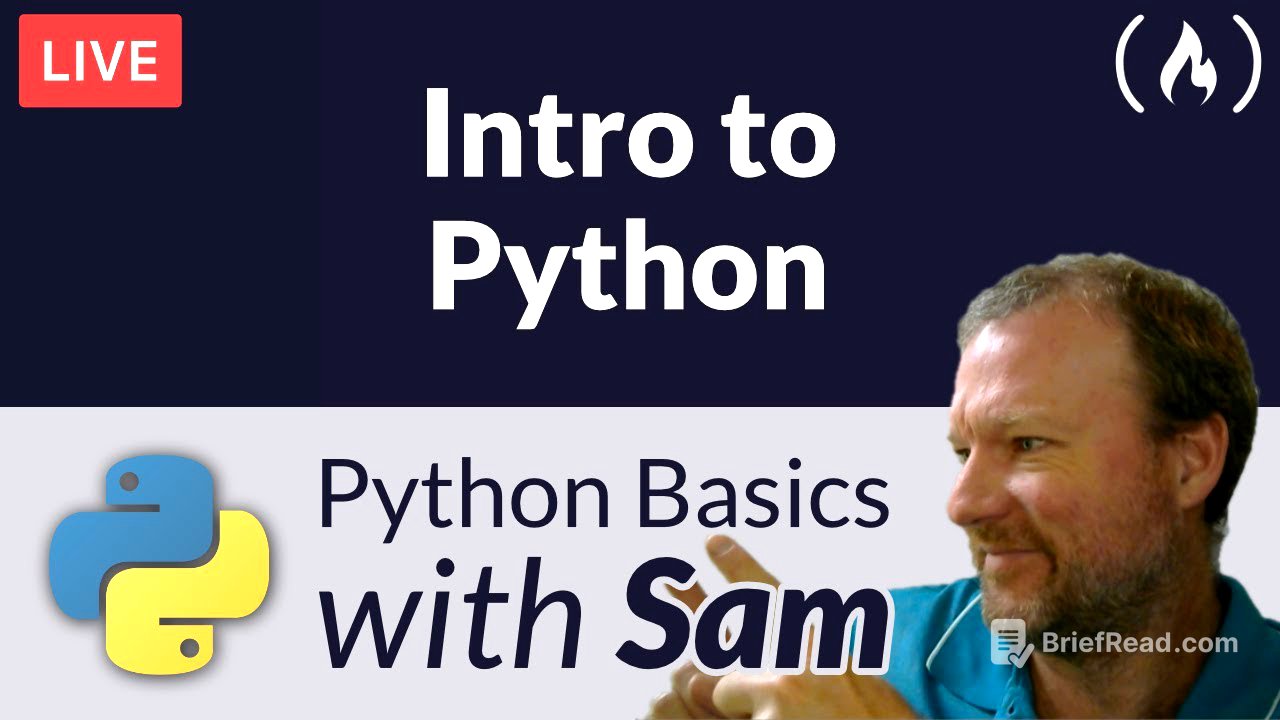TLDR;
This YouTube live stream is a beginner-friendly Python tutorial. The instructor, Sam, guides viewers through setting up Python, understanding basic variable types (integers, floats, strings, booleans), and utilizing built-in functions. The session covers essential concepts such as:
- Installing Python and understanding the IDLE shell.
- Differentiating between variable types and their uses.
- Using built-in functions like
dir,help,type, andprint. - Understanding loops (
forloop) and therangefunction for repeatability. - Working with strings, including slicing and concatenation.
- Creating and utilizing custom functions.
- Implementing conditional statements (
if,elif,else) for decision-making. - Introduction to comparison operators and boolean logic.
Installing Python and Understanding the Basics [0:15]
The tutorial starts with installing Python from python.org, specifically version 3.8.1. It emphasizes that Python is a high-level language with a strong community. The instructor introduces the Python shell (IDLE) as the primary tool for the session, highlighting that an editor is not immediately necessary.
Understanding Variables and Data Types [2:51]
The session covers four basic variable types in Python: integers, floats, strings, and booleans. An integer is a whole number, a float is a number with a decimal, a string is a sequence of characters enclosed in quotation marks, and a boolean is a binary value (True or False). The instructor explains how computers use these variables for repeatability and storing information.
Built-in Functions: dir, help, and type [4:02]
Python has built-in functions that provide information about variables and their associated methods. The dir function lists the methods and attributes available for a variable type. The help function provides detailed documentation and descriptions for these methods. The type function identifies the data type of a variable.
Strings: Definition, Rules, and Basic Operations [4:55]
Strings are defined as anything enclosed in quotation marks. The instructor recommends using double quotation marks for beginners. The session covers printing strings using the print function and demonstrates how to correct common syntax errors, such as forgetting to close quotation marks or parentheses.
Scripts: Writing and Running Python Code [16:56]
To write repeatable code, the instructor introduces Python scripts. These are created by opening a new file in IDLE, writing the code, and saving the file with a .py extension. Running the script executes the code, and the output is displayed in the shell. The instructor notes that running a script restarts the shell, clearing all previous memory.
Loops: Repeating Actions with for and range [22:35]
Loops are used to repeat a block of code multiple times. The session focuses on the for loop, which iterates over a sequence. The range function generates a sequence of numbers, which can be used to control the number of iterations. The instructor explains the syntax of the for loop, including the header (keyword for, temporary variable, keyword in, iterable, and colon) and the body (indented block of code to be executed).
Lists: Basic Containers for Storing Data [32:02]
Lists are basic containers used to store multiple items in a single variable. They are created using square brackets []. The session demonstrates how to create a list using the list() function and the range() function. The instructor also covers the rules for naming variables: they cannot contain special characters, start with a number, or be a keyword.
Slicing: Accessing Parts of Strings [50:08]
Slicing is a technique used to extract parts of a string. It uses square brackets [] with a start, stop, and step, similar to the range function. The instructor explains how to use slicing to extract substrings, reverse a string, and skip characters.
Concatenation: Combining Strings [58:19]
Concatenation is the process of combining two or more strings into a single string. The + operator is used to concatenate strings. The session demonstrates how to concatenate strings and variables to create new strings.
Functions: Creating Reusable Blocks of Code [1:03:57]
Functions are reusable blocks of code that perform a specific task. The def keyword is used to define a function. The session covers the syntax of a function, including the header (keyword def, function name, parentheses, and colon) and the body (indented block of code to be executed). The instructor explains how to call a function and pass arguments to it.
Input: Getting User Input [1:12:17]
The input() function is used to get input from the user. The function displays a prompt to the user and returns the input as a string. The session demonstrates how to use the input() function to get the user's name and then print a greeting.
Conditional Statements: Making Decisions with if, elif, and else [1:22:25]
Conditional statements are used to execute different blocks of code based on certain conditions. The if statement executes a block of code if a condition is true. The elif statement (else if) executes a block of code if the previous condition is false and the current condition is true. The else statement executes a block of code if all previous conditions are false. The session demonstrates how to use conditional statements to check if a number is even or odd, positive, negative, or zero.
Comparison Operators and Boolean Logic [1:25:16]
Comparison operators are used to compare two values. The == operator checks if two values are equal. The != operator checks if two values are not equal. The > operator checks if one value is greater than another. The < operator checks if one value is less than another. The >= operator checks if one value is greater than or equal to another. The <= operator checks if one value is less than or equal to another. Comparison operators return a boolean value (True or False).
Return Statements: Returning Values from Functions [1:39:57]
The return statement is used to return a value from a function. When a return statement is executed, the function stops executing and returns the specified value. The session demonstrates how to use the return statement to return a boolean value indicating whether a number is even or odd.
Nested Loops: Creating Patterns [1:49:50]
Nested loops are loops inside other loops. They are used to create patterns and perform more complex iterations. The session demonstrates how to use nested loops to create a square pattern of numbers. The instructor also introduces the end parameter of the print() function, which is used to suppress the new line character and print multiple values on the same line.









